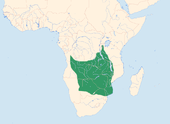Bennett Woodpecker
| Bennett Woodpecker | ||||||||||
|---|---|---|---|---|---|---|---|---|---|---|

Bennett woodpecker, female |
||||||||||
| Systematics | ||||||||||
|
||||||||||
| Scientific name | ||||||||||
| Campethera bennettii | ||||||||||
| ( Smith , 1836) |
The Bennett's Woodpecker ( Campethera bennettii ) is a species of bird from the family of woodpeckers (Picidae). This rather small species of woodpecker inhabits well-developed forest and scrubland with older trees in large parts of southern Africa. Most of the food that is sought on the ground consists mainly of ants and termites . The species is common at least in parts of its large distribution area and is classified by the IUCN as "least concern".
description
Bennett woodpeckers are quite small woodpeckers with a medium-long, pointed beak. The ridge of the beak is clearly curved downwards. The body length is about 24 cm, weight 61-84 g which they are so about the size of a woodpecker . The species shows a clear sexual dimorphism in terms of coloration .
In birds of the nominate form , the upper side including the rump and upper wing coverts as well as the lower wing coverts are banded yellow and white on a greenish beige-brown background. The basic color of the underside of the trunk is pale yellow, often with a golden brown tinge on the chest. Because of this, the breast shows strong dark spots, which usually merge into transverse bands on the flanks. The under tail-coverts are mostly spotted or cross-banded on a white background. The wings are brown with greenish lined outer flags and yellowish white bands on the inner flags . The tail top is brown and pale yellow quergebändert, the underside is yellowish, often show the tail feathers black lace.
In the male, the forehead, skull and neck are red, on the forehead the red feathers have a gray base. A wide red stripe of beard with isolated black feathers extends from the base of the beak to under the ear covers . Otherwise, the sides of the head, like the throat and chin, are plain white. Females have a black forehead and an equally colored front skull with white spots; the back of the skull and neck are red like the male. A broad brown stripe runs from the base of the upper beak along the lower edge of the eye to the ear covers, the chin and throat are also brown. The streak of beard is white.
The beak is dark gray, lightened at the base. The legs and toes are bluish gray to gray-green. The iris is red in adult birds and dark brown in juvenile plumage.
distribution and habitat
Bennett woodpeckers inhabit large parts of southern Africa. The distribution area extends in a west-east direction from mid-west Angola and north-east Namibia to west and south Tanzania , west Malawi and south Mozambique , in north-south direction from south-east of the Democratic Republic of the Congo and Tanzania to Botswana , Transvaal and to the northeast of KwaZulu-Natal .
The species inhabits well-developed forest and scrubland with older trees, especially Miombo and Gusu as well as dry landscapes characterized by acacias . The animals occur in the east of Africa up to an altitude of 1600 m.
Systematics
Winkler et al. recognize only two subspecies:
- Campethera bennettii bennettii ( A. Smith , 1836) ; largest part of the distribution area
- Campethera bennettii capricorni Strickland , 1853 ; Southern Angola, southwest Zambia and adjacent parts in northern Namibia and Botswana; somewhat larger than the nominate shape, with paler upper side and upper tail-coverts, lower side overall more intense yellow with less pronounced or occasionally no dark spots. Females have a much blacker strip of the ear cover, and their chin and throat are just as dark.
nutrition
The food mainly consists of ants and termites , occasionally other insects and their larvae are also eaten. 70-85% of the foraging takes place on the ground. In the tree layer, the animals usually look for prey on trunks and thick branches, where the food is mainly read or chopped out from crevices.
Reproduction
According to previous knowledge, Bennett woodpeckers breed between August and February, in Zimbabwe and the Transvaal, with a focus on October and November. The caves are created in dead trees or dead parts of living trees, but previously used caves are often reoccupied or natural caves and caves built by other species of woodpecker are used. The clutch consists of 3 to 5, usually 3 eggs, which are incubated by both parents for 15-18 days. The young birds that have flown out remain in their parents' territory until preparations for the next brood are made.
Existence and endangerment
The species is common in parts of its large area of distribution, rarely or extensively absent in others. It is classified by the IUCN as “least concern”.
swell
literature
- Hans Winkler , David A. Christie, David Nurney: Woodpeckers. A Guide to the Woodpeckers, Piculets, and Wrynecks of the World. Pica Press, Robertsbridge 1995, ISBN 0-395-72043-5 , pp. 70-71 and 228-229.
Individual evidence
- ↑ Hans Winkler, David A. Christie, David Nurney: Woodpeckers. A Guide to the Woodpeckers, Piculets, and Wrynecks of the World. Pica Press, Robertsbridge 1995, p. 229.
Web links
- Campethera bennettii in the Red List of Threatened Species of the IUCN 2009. Posted by: BirdLife International, 2009. Accessed on 8 February, 2010.
- Videos, photos and sound recordings of Campethera bennettii in the Internet Bird Collection , accessed December 11, 2009
